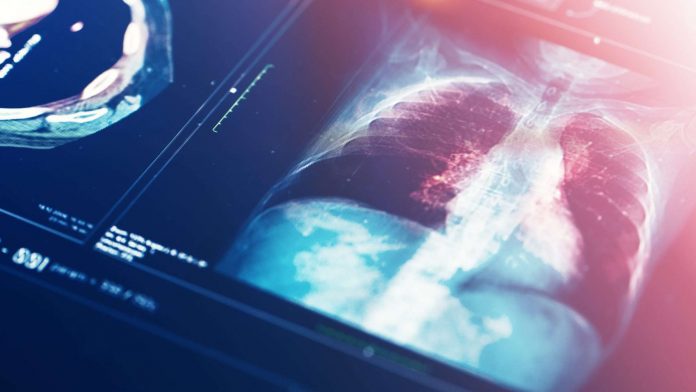Pneumonia is an infection caused by bacteria, viruses, or fungi. It leads to inflammation in the air sacs of one or both lungs. These sacs, called alveoli, fill with fluid or pus, making it difficult to breathe.
Both viral and bacterial pneumonia is contagious. This means they can spread from person to person through inhalation of airborne droplets from a sneeze or cough.
You can also get these types of pneumonia by coming into contact with surfaces or objects that are contaminated with pneumonia-causing bacteria or viruses.
You can contract fungal pneumonia from the environment. It does not spread from person to person.
Pneumonia is further classified according to where or how it was acquired:
Hospital-acquired pneumonia (HAP). This type of bacterial pneumonia is acquired during a hospital stay. It can be more serious than other types, as the bacteria involved may be more resistant to antibiotics.
Community-acquired pneumonia (CAP). This refers to pneumonia that’s acquired outside of a medical or institutional setting.
Ventilator-associated pneumonia (VAP). When people who are using a ventilator get pneumonia, it’s called VAP.
Aspiration pneumonia. Inhaling bacteria into your lungs from food, drink, or saliva can cause aspiration pneumonia. It’s more likely to occur if you have a swallowing problem, or if you’re too sedated from the use of medications, alcohol, or other drugs.
Walking pneumonia
Walking pneumonia is a milder case of pneumonia. People with walking pneumonia may not even know they have pneumonia. Their symptoms may feel more like a mild respiratory infection than pneumonia. However, walking pneumonia may require a longer recovery period.
The symptoms of walking pneumonia can include things like:
mild fever
dry cough lasting longer than a week
chills
shortness of breath
chest pain
reduced appetite
Viruses and bacteria, like Streptococcus pneumoniae or Haemophilus influenzae, often cause pneumonia. However, in walking pneumonia, the bacteria Mycoplasma pneumoniae most commonly causes the condition.
Pneumonia stages
Pneumonia may be classified based off the area of the lungs it’s affecting:
Bronchopneumonia
Bronchopneumonia can affect areas throughout both of your lungs. It’s often localized close to or around your bronchi. These are the tubes that lead from your windpipe to your lungs.
Lobar pneumonia
Lobar pneumonia affects one or more lobes of your lungs. Each lung is made of lobes, which are defined sections of the lung.
Lobar pneumonia can be further divided into four stages based off how it’s progressed:
Congestion. Lung tissue appears heavy and congested. Fluid filled with infectious organisms has accumulated in the air sacs.
Red hepatization. Red bloods cells and immune cells have entered into the fluid. This makes the lungs appear red and solid in appearance.
Gray hepatization. The red blood cells have begun to break down while immune cells remain. The breakdown of red blood cells causes a change in color, from red to gray.
Resolution. Immune cells have begun to clear the infection. A productive cough helps eject remaining fluid from the lungs.
Symptoms
Pneumonia symptoms can be mild to life threatening. They can include:
coughing that may produce phlegm (mucus)
fever
sweating or chills
shortness of breath that happens while doing normal activities, or even while resting
chest pain that’s worse when you breathe or cough
feelings of tiredness or fatigue
loss of appetite
nausea or vomiting
headaches
Other symptoms can vary according to your age and general health:
Infants may appear to have no symptoms, but sometimes they may vomit, lack energy, or have trouble drinking or eating.
Children under 5 years old may have fast breathing or wheezing.
Older adults may have milder symptoms. They can also experience confusion or a lower-than-normal body temperature.
Causes
Pneumonia happens when germs get into your lungs and cause an infection. The immune system’s reaction to clear the infection results in inflammation of the lung’s air sacs (alveoli). This inflammation can eventually cause the air sacs to fill up with pus and liquids, causing pneumonia symptoms.
Several types of infectious agents can cause pneumonia, including bacteria, viruses, and fungi.
Bacterial pneumonia
The most common cause of bacterial pneumonia is Streptococcus pneumoniae. Other causes include:
Mycoplasma pneumoniae
Haemophilus influenzae
Legionella pneumophila
Viral pneumonia
Respiratory viruses are often the cause of pneumonia. Examples of viral infections that can cause pneumonia include:
influenza (flu)
respiratory syncytial virus (RSV)
rhinoviruses (common cold)
human parainfluenza virus (HPIV) infection
human metapneumovirus (HMPV) infection
measles
chickenpox (varicella-zoster virus)
adenovirus infection
coronavirus infection
SARS-CoV-2 infection (the virus that causes COVID-19)
Although the symptoms of viral and bacterial pneumonia are very similar, viral pneumonia is usually milder. It can improve in 1 to 3 weeks without treatment.
According to the National Heart, Lung, and Blood , people with viral pneumonia are at risk of developing bacterial pneumonia.
Fungal pneumonia
Fungi from soil or bird droppings can cause pneumonia. They most often cause pneumonia in people with weakened immune systems. Examples of fungi that can cause pneumonia include:
Pneumocystis jirovecii
Cryptococcus species
Histoplasmosis species
Risk factors
Anyone can get pneumonia, but certain groups do have a higher risk. These groups include:
infants from birth to 2 years old
people ages 65 and older
people with weakened immune systems due to:
pregnancy
HIV
the use of certain medications, such as steroids or certain cancer drugs
people with certain chronic medical conditions, such as:
asthma
cystic fibrosis
diabetes
COPD
heart failure
sickle cell disease
kidney disease
people who’ve been recently or are currently hospitalized, particularly if they were or are on a ventilator
people who’ve had a brain disorder, which can affect the ability to swallow or cough, such as:
stroke
head injury
dementia
Parkinson’s disease
people who’ve been regularly exposed to lung irritants, such as air pollution and toxic fumes, especially on the job
people who live in a crowded living environment, such as a prison or nursing home
people who smoke, which makes it more difficult for the body to get rid of mucus in the airways
people who use drugs or drink heavy amounts of alcohol, which weakens the immune system and increases the odds of inhaling saliva or vomit into the lungs due to sedation
Diagnosis
Your doctor will start by taking your medical history. They’ll ask you questions about when your symptoms first appeared and your health in general.
They’ll then give you a physical exam. This will include listening to your lungs with a stethoscope for any abnormal sounds, such as crackling.
Depending on the severity of your symptoms and your risk of complications, your doctor may also order one or more of these tests:
Chest X-ray
An X-ray helps your doctor look for signs of inflammation in your chest. If inflammation is present, the X-ray can also inform your doctor about its location and extent.
Blood culture
This test uses a blood sample to confirm an infection. Culturing can also help identify what may be causing your condition.
Sputum culture
During a sputum culture, a sample of mucus is collected after you’ve coughed deeply. It’s then sent to a lab to be analyzed to identify the cause of the infection.
Pulse oximetry
A pulse oximetry measures the amount of oxygen in your blood. A sensor placed on one of your fingers can indicate whether your lungs are moving enough oxygen through your bloodstream.
CT scan
CT scans provide a clearer and more detailed picture of your lungs.
Fluid sample
If your doctor suspects there’s fluid in the pleural space of your chest, they may take a fluid sample using a needle placed between your ribs. This test can help identify the cause of your infection.
Bronchoscopy
A bronchoscopy looks into the airways in your lungs. It does this using a camera on the end of a flexible tube that’s gently guided down your throat and into your lungs.
Your doctor may do this test if your initial symptoms are severe, or if you’re hospitalized and not responding well to antibiotics.
If you need help finding a primary care doctor, then check out our tool here.
Treatment
A pulse oximetry measures the amount of oxygen in your blood. A sensor placed on one of your fingers can indicate whether your lungs are moving enough oxygen through your bloodstream.
CT scans provide a clearer and more detailed picture of your lungs.
Fluid sample
If your doctor suspects there’s fluid in the pleural space of your chest, they may take a fluid sample using a needle placed between your ribs. This test can help identify the cause of your infection.
Bronchoscopy
A bronchoscopy looks into the airways in your lungs. It does this using a camera on the end of a flexible tube that’s gently guided down your throat and into your lungs.
Your doctor may do this test if your initial symptoms are severe, or if you’re hospitalized and not responding well to antibiotics.
If you need help finding a primary care doctor, then check out our FindCare tool here.
Prescription medications
Your doctor may prescribe a medication to help treat your pneumonia. What you’re prescribed will depend on the specific cause of your pneumonia.
Oral antibiotics can treat most cases of bacterial pneumonia. Always take your entire course of antibiotics, even if you begin to feel better. Not doing so can prevent the infection from clearing, and it may be harder to treat in the future.
Antibiotic medications don’t work on viruses. In some cases, your doctor may prescribe an antiviral. However, many cases of viral pneumonia clear on their own with at-home care.
Antifungal medications are used to treat fungal pneumonia. You may have to take this medication for several weeks to clear the infection.
OTC medications
Your doctor may also recommend over-the-counter (OTC) medications to relieve your pain and fever, as needed. These may include:
aspirin
ibuprofen (Advil, Motrin)
acetaminophen (Tylenol)
Your doctor may also recommend cough medicine to calm your cough so you can rest. Keep in mind coughing helps remove fluid from your lungs, so you don’t want to eliminate it entirely.
Home remedies
Although home remedies don’t actually treat pneumonia, there are some things you can do to help ease symptoms.
Coughing is one of the most common symptoms of pneumonia. Natural ways to relieve a cough include gargling salt water or drinking peppermint tea.
Cool compresses can work to relieve a fever. Drinking warm water or having a nice warm bowl of soup can help with chills. Here are more home remedies to try.
You can help your recovery and prevent a recurrence by getting a lot of rest and drinking plenty of fluids.
Although home remedies can help ease symptoms, it’s important to stick to your treatment plan. Take any prescribed medications as directed.
Hospitalization
If your symptoms are very severe or you have other health problems, you may need to be hospitalized. At the hospital, doctors can keep track of your heart rate, temperature, and breathing. Hospital treatment may include:
antibiotics injected into a vein
respiratory therapy, which involves delivering specific medications directly into the lungs, or teaching you to perform breathing exercises to maximize your oxygenation
oxygen therapy to maintain oxygen levels in your bloodstream (received through a nasal tube, face mask, or ventilator, depending on severity)
Complications
Pneumonia may cause complications, especially in people with weakened immune systems or chronic conditions, such as diabetes.
Complications may include:
Worsened chronic conditions. If you have certain preexisting health conditions, pneumonia could make them worse. These conditions include congestive heart failure and emphysema. For certain people, pneumonia increases their risk of having a heart attack.
Bacteremia. Bacteria from the pneumonia infection may spread to your bloodstream. This can lead to dangerously low blood pressure, septic shock, and, in some cases, organ failure.
Lung abscesses. These are cavities in the lungs that contain pus. Antibiotics can treat them. Sometimes they may require drainage or surgery to remove the pus.
Impaired breathing. You may have trouble getting enough oxygen when you breathe. You may need to use a ventilator.
Acute respiratory distress syndrome. This is a severe form of respiratory failure. It’s a medical emergency.
Pleural effusion. If your pneumonia isn’t treated, you may develop fluid around your lungs in your pleura, called pleural effusion. The pleura are thin membranes that line the outside of your lungs and the inside of your rib cage. The fluid may become infected and need to be drained
Kidney, heart, and liver damage. These organs may be damaged if they don’t receive
Kidney, heart, and liver damage. These organs may be damaged if they don’t receive enough oxygen, or if there’s an overreaction of the immune system to the infection.
Death. In some cases, pneumonia can be fatal. According to the CDC, nearly 44,000 peopleTrusted Source in the United States died from pneumonia in 2019.
Prevention
In many cases, pneumonia can be prevented.
Vaccination
The first line of defense against pneumonia is to get vaccinated. There are several vaccines that can help prevent pneumonia.
Prevnar 13 and Pneumovax 23
These two pneumonia vaccines help protect against pneumonia and meningitis caused by pneumococcal bacteria. Your doctor can tell you which one might be better for you.
Prevnar 13 is effective against 13 types of pneumococcal bacteria. The CDCTrusted Source recommends this vaccine for:
children under age 2
people between ages 2 and 64 with chronic conditions that increase their risk of pneumonia
adults ages 65 and older, on the recommendation of their doctor
Pneumovax 23 is effective against 23 types of pneumococcal bacteria. The CDCTrusted Source recommends it for:
adults ages 65 and older
adults ages 19 to 64 who smoke
people between ages 2 and 64 with chronic conditions that increase their risk of pneumonia
Flu vaccines
Pneumonia can often be a complication of the flu, so be sure to also get an annual flu shot. The CDCTrusted Source recommends that everyone ages 6 months and older get vaccinated, particularly those who may be at risk of flu complications.
Hib vaccine
This vaccine protects against Haemophilus influenzae type b (Hib), a type of bacterium that can cause pneumonia and meningitis. The CDCTrusted Source recommends this vaccine for:
all children under 5 years old
unvaccinated older children or adults who have certain health conditions
people who’ve gotten a bone marrow transplant
According to the National Heart, Lung, and Blood InstituteTrusted Source, pneumonia vaccines won’t prevent all cases of the condition.
But if you’re vaccinated, you’re likely to have a milder and shorter illness as well as a lower risk of complications.
Other prevention tips
In addition to vaccination, there are other things you can do to avoid pneumonia:
If you smoke, try to quit. Smoking makes you more susceptible to respiratory infections, especially pneumonia.
Regularly wash your hands with soap and water for at least 20 seconds.
Cover your coughs and sneezes. Promptly dispose used tissues.
Maintain a healthy lifestyle to strengthen your immune system. Get enough rest, eat a balanced diet, and get regular exercise.
Together with vaccination and additional prevention steps, you can help reduce your risk of getting pneumonia. Here are even more prevention tips.
Is pneumonia curable?
A variety of infectious agents cause pneumonia. With proper recognition and treatment, many cases of pneumonia can be cleared without complications.
For bacterial infections, stopping your antibiotics early can cause the infection to not clear completely. This means your pneumonia could come back.
Stopping antibiotics early can also contribute to antibiotic resistance. Antibiotic-resistant infections are more difficult to treat.
Viral pneumonia often resolves in 1 to 3 weeks with at-home treatment. In some cases, you may need antivirals.
Antifungal medications treat fungal pneumonia. It may require a longer period of treatment.
Pneumonia in pregnancy
Pneumonia that occurs during pregnancy is called maternal pneumonia. Pregnant people are more at risk of developing conditions like pneumonia. This is due to the natural suppression of the immune system that happens during pregnancy.
The symptoms of pneumonia don’t differ by trimester. However, you may notice some of them more later on in your pregnancy due to other discomforts you may be encountering.
If you’re pregnant, contact your doctor as soon as you start experiencing symptoms of pneumonia. Maternal pneumonia can lead to a variety of complications, such as premature birth and low birth weight.
Pneumonia in kids
Pneumonia can be a rather common childhood condition. Approximately 1 in 71 children worldwide get pneumonia worldwide each year, according to the United Nations Children’s Fund (UNICEF).
The causes of childhood pneumonia can vary by age. For example, pneumonia due to respiratory viruses, Streptococcus pneumoniae, and Haemophilus influenzae is more common in children under 5 years old.
Pneumonia due to Mycoplasma pneumoniae is frequently observed in children between the ages of 5 and 13. Mycoplasma pneumoniae is one of the causes of walking pneumonia. It’s a milder form of pneumonia.
See your pediatrician if you notice your child:
is having trouble breathing
lacks energy
has changes in appetite
Pneumonia can become dangerous quickly, particularly in young children. Here’s how to avoid complications.






























